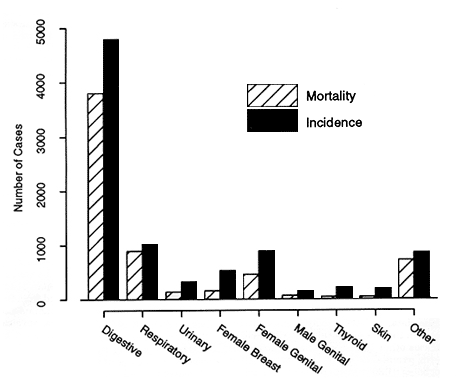Cancer Incidence and Mortality in the LSS, 1958-1987
This article was originally published in RERF Update 3(1):9, 1991.
To date, most reports on the late effects of radiation on cancer in the Life Span Study cohort have focused on mortality. In recent years, a major effort has been made to include the quality of the population-based Hiroshima and Nagasaki tumor registries in RERF studies by producing a registry of cancer incidence in the LSS. Important for several reasons–including better diagnostic quality and a greater quantity of cases–LSS cancer incidence will be reported soon in a series of comprehensive reports. Having a greater number of cases is particularly important for relatively nonlethal cancers, such as cancers of the breast, thyroid, and skin, for which analyses of mortality are of little, if any, use.
Not established in Nagasaki until 1957 and in Hiroshima until 1958, the tumor registries are mainly limited by incomplete coverage of the LSS cohort, which includes people who have migrated from the registry catchment areas.
The accompanying Figure compares the number of solid tumor cases available for mortality and incidence analyses of the LSS from 1958 through 1987 (the period covered in the tumor registry reports). During this time, 22,187 deaths occurred among LSS members, of which 6,336 were coded as cancer deaths on death certificates, whereas the registries contain data on 9,010 first primary tumors.
Even for categories comprising generally fatal tumors, such as digestive and respiratory tumors, the tumor registries contain about 20% more cases than are reported in the mortality series. This results from including living cases in the registry data and from inaccuracies in the cause of death as reported on death certificates. For less fatal cancers, the differences are even more striking; for breast cancer, the registry series includes 3.3 times as many cases as the mortality series, whereas for thyroid and skin cancer, respectively, the numbers of cases in the registry are 4.4 and 4.8 times the number of cases in the mortality data.

Figure. Solid tumor cases available for mortality and incidence analysis of the Life Span Study, 1958-1987.

